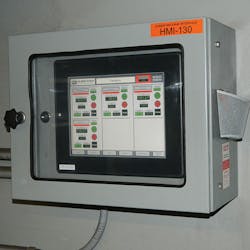Manufacturing intelligence and data governance are huge challenges right now for most industrial plants, and Massachusetts-based Palmer Foundry is no exception. This manufacturer of aluminum castings found itself needing to provide more quality control data as the quality requirements of its customers in the semiconductor, automotive, energy and aerospace industries become more stringent.
Palmer Foundry has three plants on its nine-acre campus in Palmer, Mass., and each project in those plants involves demanding specifications and diligent control of raw materials and processes. “We are heavily involved in the semiconductor capital equipment market, so they were driving us toward more quality control assurances,” says Jim Lagrant, general manager.
The casting process requires high volumes of energy. Raw materials include engineered sand and aluminum ingot in high volumes, and both the sand and alloys are specifically produced to Palmer Foundry’s specifications. Each casting includes specific percentages of constituent elements, such as silicon, titanium, copper and magnesium, and these meet the standards formed by the Aluminum Association.
“If these elements fall out of specification, the casting may not meet the published tensile, yield and elongation values,” says Lagrant. “Contamination from other elements will adversely affect the fluidity of the molten metal, and potentially cause voids in the casting.”
Elements such as nickel, copper and chromium also pose huge contamination risks to semiconductor clients. “Specifying, tracking and controlling our supply of raw ingot ensures that our castings meet the alloy specifications, mechanical properties, metal integrity and cleanliness specifications,” Lagrant adds.
Historically, because of its smaller company size, Palmer Foundry did not spend much time in systems engineering. As a result, its quality data streams and components were not mapped. That meant there was duplication of effort, obsolete or irrelevant data, and a lack of clarity about who was responsible for certain data sets. Disparate data in multiple laptops and databases created a growing urgency to solve the problem, so Palmer Foundry purchased Quality Analyst software from Northwest Analytics (www.nwasoft.com), a manufacturing intelligence software supplier.
The Quality Analyst statistical process control (SPC) software package provides data charting and analysis for routine process management as well as continuous process improvement and Six Sigma programs.
Because of the large amount of disparate project data existing within the enterprise, however, Palmer Foundry quickly transitioned to Northwest Analytics’ Focus Enterprise Manufacturing Intelligence (EMI) software.
With the SPC software, past quality-control data was not easily accessible, and other data—data to inform customers, review and analyze projects, or monitor raw material supplies and scrap rates—were scattered across laptops. This meant data resided in silos and, effectively, no data governance rules were applied.
The EMI software from Northwest Analytics addresses the data-access issue by establishing a “data definition layer” that defines specific data elements. Definitions are created by grouping data elements by source and by how they are associated. After queries are done—using ODCB and OLE-D technology—an analytics definition is applied that is specific to each grouping of data elements. This creates a highly granular data definition layer that allows the flexibility to define data queries specific to groups of related data elements. It also creates a deployed system that is resistant to problems with individual data connections.
Project data locations
With limited Information Technology (IT) resources, one of Palmer Foundry’s first tasks was to unravel where the project data was coming from, who was collecting it, where it was stored, and who was responsible for analyzing the data and making decisions.
“This process took about two months, and the end result was that I was able to streamline our data flow, transition our external data from paper to electronic format, consolidate the storage locations, and begin to connect to our data sources,” Lagrant says.
IT involvement was minimal, Lagrant adds. “Our IT associate was involved in setting file permissions, helping establish our plant databases, configuring our email services, and assisting in the EMI server and client installation. NWA’s tech support provided support on the installation in one afternoon, and the EMI software was producing real-time information within a week.”
Another benefit with the plug-and-play EMI software is that it allows process engineers and quality staff—not IT—to manage definitions, configurations and deployment after the data connections are established in the different data silos, Lagrant says.
With NWA’s Focus EMI, Palmer Foundry can validate the content of raw materials prior to them entering the manufacturing line, eliminating materials problems before they can disrupt the process.
“All of the critical raw material and process data is now available on-screen,” says Lagrant. Before, Palmer Foundry would have to first locate and then compile paper copies of raw material certificates of compliance. Now, raw material data, and the processes’ effects on that raw material, is available in real time.
Palmer Foundry is also using Focus EMI to track and chart key business metrics such as on-time delivery, customer returns, percent overtime and bookings.
Better visibility
The data transition has led to better visibility into trends and more proactive operators. “By spotting process trends, vs. relying solely on tabular data, our process owners are able to identify issues much sooner,” reports Lagrant. They can distinguish an out-of-control process from an out-of-spec process, for example. This trend data is shared with the process operators, who can then diagnose which of the three Ms are affecting the process: the method, the material or the machine, says Lagrant.
Lagrant adds that once corrective or preventive actions have been implemented, “the same control charts let us know how effective the change was. Offline analytics have also helped us identify measurements that we believed correlated with product quality, but in fact did not.”
With the transition over, Palmer Foundry’s new manufacturing intelligence system allows the company to provide quality control data quickly, leaving more time to find further efficiencies.
About the Author
Grant Gerke
Digital Managing Editor

Leaders relevant to this article:
